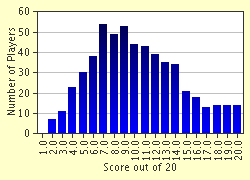Quiz Answer Key and Fun Facts
1. The Messerschmitt Bf.109 was one of many earlier Messerschmitt designs that did not employ the abbreviation Me. as a prefix in its name. What did Bf. stand for?
2. The Allies devised a system of code names to aid recognition of Japanese aircraft. Masculine names were given to fighters, feminine names to bombers and reconnaissance aircraft. What types of names were given to training aircraft?
3. All Japanese Army aircraft were designated with a Ki- prefix followed by a number (e.g. Ki-46). What did Ki- stand for?
4. Italian aircraft also had an abbreviation as a prefix before their production number (e.g. Macchi C.200). Generally, what did this prefix identify?
5. As an example of Japanese Naval aircraft nomenclature, which digit of the famous A6M2 'Zero' aircraft indicated that it was a carrier-based fighter aircraft?
6. At the beginning of what year did the Soviet Air Force change its designations for aircraft from initials indicating its role (e.g SB-2 and DB-3) to the initials of the design bureau from which it came(e.g. Yak-9 and Tu-2)?
7. With the proliferation of sub-series of many German types, some were given an additional suffix, particularly later in the war. In the Messerschmitt Bf.109F-4/R1, for example, the R was an abbreviation of 'Rustsatz'. What did this word indicate?
8. In the US Army Air Force, the A-prefix indicated that the type was a light bomber or attack aircraft (e.g. A-20 Havoc). This designation was the same for US Navy aircraft.
9. What were SNCAO, SECM, SNCASCO, SNCAC, SNCAN, SNCASO, etc. in relation to French military aircraft?
10. What abbreviation on a British aircraft indicated that it had been modified for desert or jungle conditions?
11. If a Japanese Army aircraft had a -KAI suffix after its designation, (e.g. Ki-45 KAI) this signified that it was a modified version.
12. Later Focke-Wulf designs, such as the Ta.152 and Ta.154, carried the abbreviation of their chief designer. His first name was Kurt - but what was his second name that the Ta. stood for?
13. What was the designation of the Bell Airacobra fighters that were rejected for RAF service and diverted to the USAAF instead?
14. An important Russian aircraft in the early part of the conflict on the Eastern Front was the Polikarpov I-16. The I- prefix indicated 'Istrebetl'. What does this word translate as?
15. The Romanians' only modern fighter of indigenous design was the IAR 80. The initials IAR were an abbreviation of the words describing its role.
16. In US Navy nomenclature, what letter was used to identify Grumman as the aircraft's manufacturer?
17. Which part of the name of the PBY Catalina told you its manufacturer?
18. On Dutch Fokker designs, what letter prefix indicated that it was a single-seat fighter type?
19. Everyone's heard of the famous P-51 Mustang. But what did the P- prefix indicate about the role of the US Army aircraft it described?
20. There was confusion for years after the war about whether Yugoslavia's only wartime indigenous fighter of modern design was designated the IK-3 or the IK-Z.
Source: Author
Plumbus
This quiz was reviewed by FunTrivia editor
bloomsby before going online.
Any errors found in FunTrivia content are routinely corrected through our feedback system.


